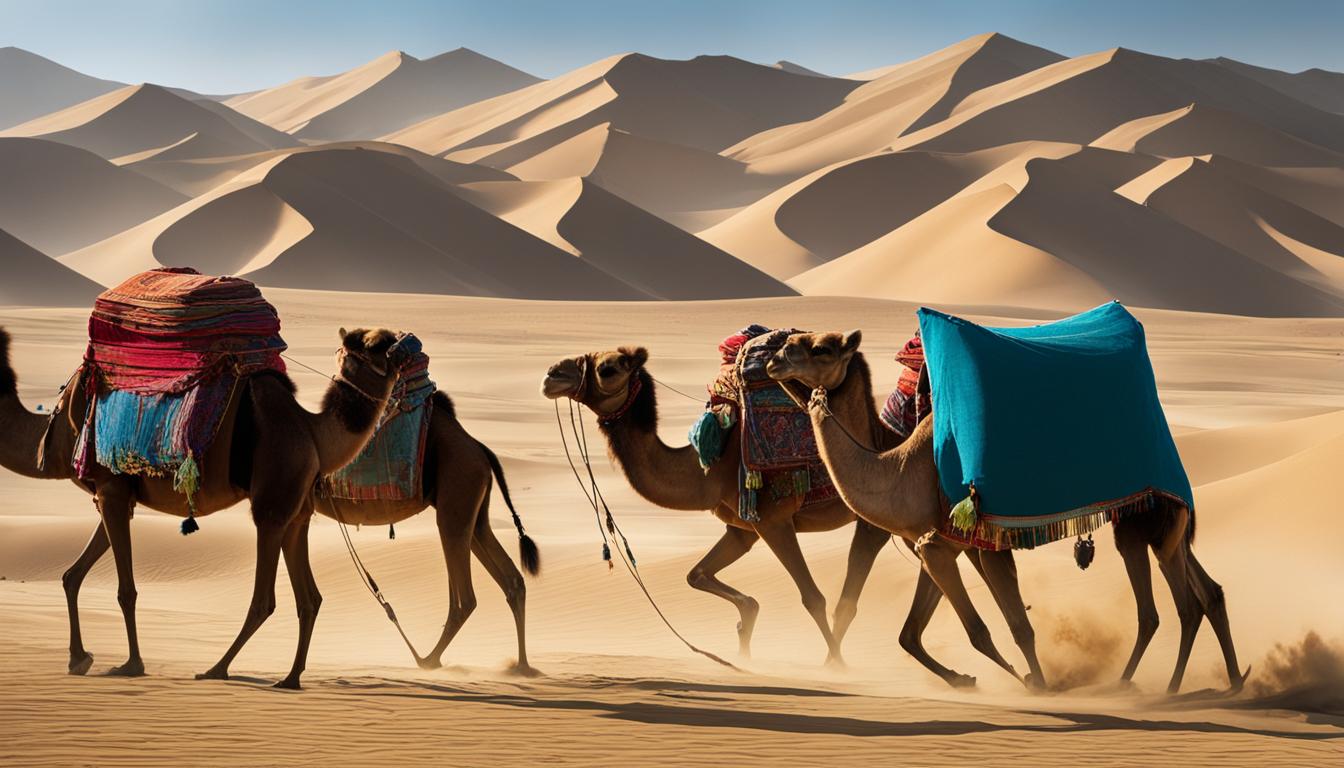The Silk Road trade routes have a rich history that spans over 1,500 years, starting from 130 B.C.E. until 1453 C.E. These ancient trade routes connected Europe and East Asia, fostering the exchange of goods and ideas between diverse cultures along the way.
The Silk Road covered a vast distance of approximately 6,437 kilometers (4,000 miles), traversing challenging terrains such as the vast Gobi Desert and the imposing Pamir Mountains. To ensure their safety, traders formed caravans and sought refuge in caravanserais, which were inns strategically placed along the routes.
Various commodities were transported along the Silk Road, including luxurious silk, shimmering jade, delicate porcelain, aromatic spices, exquisite tea, fine textiles, and refined glassware. The Silk Road not only facilitated trade but also played a crucial role in shaping the course of history, as it fostered the spread of religions, ideas, technologies, and even diseases.
One renowned explorer who embarked on a journey along the Silk Road was Marco Polo, whose vivid accounts continue to inspire and captivate generations.
Key Takeaways:
- The Silk Road trade routes spanned over 1,500 years, connecting Europe and East Asia.
- The Silk Road covered a distance of approximately 6,437 kilometers (4,000 miles) and passed through challenging landscapes.
- Traders formed caravans for protection and found respite in caravanserais.
- A wide range of goods, including silk, jade, porcelain, and spices, were traded along the Silk Road.
- The Silk Road facilitated the spread of religions, ideas, technologies, and diseases.
The Silk Road: Routes and Trading

The Silk Road, an ancient trade network, encompassed multiple routes that provided various options for travelers. The journey typically began in Xi’an, China, and stretched across diverse regions such as the Great Wall of China, the Pamirs, Afghanistan, and the Levant. From there, goods were transported to Europe via the Mediterranean Sea, opening up a world of commerce and cultural exchange.
As the Silk Road evolved, civilizations flourished along its path, and cities transformed into bustling hubs of trade and interaction. This vibrant network allowed merchants to engage in the exchange of a wide range of valuable goods. Items such as luxurious silk, aromatic spices, captivating precious stones, and exquisite textiles were among the treasures traded.
The remarkable trade along the Silk Road not only enriched the material wealth of the participating merchants, but it also fostered the intermingling of cultures, languages, and ideas. This transcontinental route brought people of diverse backgrounds into contact with each other, creating a melting pot of exchange and exploration.
Moving goods along the Silk Road was no small feat. Merchants formed caravans, ensuring the safety of their valuable cargo. They made strategic stops at various points along the route, allowing them to rest, replenish supplies, and engage in further trading. These stopovers, such as the famous caravanserais, not only provided respite but also served as crucial meeting places for merchants from different regions.
The trade routes of the Silk Road allowed for the connection of merchants and cultures, shaping the course of history. It facilitated the flow of ideas, technologies, and religious beliefs, paving the way for the development of civilizations. The Silk Road traversed vast landscapes, creating an intricate web of connections that solidified its place as one of the most significant trade routes in history.
Exploring the Silk Road destinations reveals a tapestry of civilizations and the vibrant trading that took place along its path. From the magnificent cities of Xi’an and Samarkand to the bustling marketplaces of Aleppo and Constantinople, the Silk Road left an indelible mark on the cultures it touched.
Quotes:
“The Silk Road was not just a trading route but a cultural bridge that connected East and West.” – Wang Wei
Silk Road Trading Goods
| Goods | Origin | Destination |
|---|---|---|
| Silk | China | Europe |
| Spices | India, Middle East | Europe, China |
| Precious Stones | Central Asia, India | China, Rome |
| Textiles | India, Persia | China, Europe |
Influence of the Silk Road on History and Culture
The Silk Road was not just a trade route; it was a conduit for the exchange of goods, ideas, and cultures between diverse civilizations. This vibrant network of ancient roads played a pivotal role in shaping the course of history, with profound effects on both religious beliefs and cultural practices. Travelers along the Silk Road encountered different civilizations and carried the influence of these encounters back to their homelands.
Religions such as Buddhism, Christianity, Islam, Hinduism, Zoroastrianism, and Manicheism spread along the Silk Road, transcending geographical boundaries. Buddhist monks, Christian missionaries, Islamic scholars, and other religious figures embarked on arduous journeys along the Silk Road, enlightening and inspiring individuals across its vast expanse. The Silk Road became a channel for the transmission of spiritual beliefs, leading to the creation of diverse religious communities and the fusion of cultural practices.
However, cultural and religious exchange was not the only consequence of the Silk Road. The interaction between civilizations also fostered the transmission of knowledge, arts, literature, and technological advancements. Cities along the Silk Road, such as Samarkand, Bukhara, and Kashgar, became vibrant centers of culture and learning, attracting scholars, artisans, and philosophers. This intellectual exchange gave rise to new ideas, artistic styles, and scientific breakthroughs that enriched the societies along the Silk Road.
The Legacy of the Silk Road
To this day, the impact of the Silk Road can be witnessed in the form of historic buildings, monuments, and archaeological sites that dot its course. These remnants of the past serve as tangible reminders of the connections forged between civilizations along the Silk Road. The Silk Road also contributed to the development of diverse societies with their unique cultures, languages, and traditions. The blending of customs, traditions, and artistic styles shaped the vibrant and multicultural communities that emerged along the Silk Road.
“The Silk Road was a bridge that connected East and West, allowing for the flow of ideas, cultures, and goods. Its influence on history and culture is immeasurable.” – Scholar
It is impossible to overstate the significance of the Silk Road in fostering intercultural understanding and shaping the history of the regions it traversed. This ancient trade route opened doors to new possibilities, breaking down barriers and inspiring innovation across borders. The Silk Road map and the rich Silk Road culture continue to captivate the imagination, reminding us of the power of exchange and the interconnectedness of human civilization.
| Impact of the Silk Road | Description |
|---|---|
| Religious Spread | The Silk Road facilitated the spread of major world religions such as Buddhism, Christianity, Islam, Hinduism, Zoroastrianism, and Manicheism. |
| Cultural Exchange | The Silk Road fostered the exchange of ideas, traditions, arts, and literature, resulting in the development of rich and diverse cultures. |
| Technological Transmission | Technological advancements and inventions were disseminated along the Silk Road, revolutionizing societies and propelling progress. |
| Economic Development | The Silk Road facilitated trade, stimulating economic growth and the exchange of valuable goods such as silk, spices, and precious stones. |
Silk Production and the Spread of Silk
Silk production has a rich history that dates back to ancient China. Originating around 2,700 BCE, silk quickly became a highly prized and valuable product. The process of making silk, known as sericulture, was a closely guarded secret and initially reserved exclusively for the Chinese imperial court.
The demand for silk eventually led to its spread beyond China, reaching ancient Rome in the 1st century BCE. The Romans were captivated by the luxurious fabric, and silk quickly gained popularity throughout the Middle Ages.
The importance of silk in trade and commerce cannot be understated. The demand for this exquisite fabric resulted in the establishment of trade routes connecting Europe to the Far East. These routes, collectively known as the Silk Road, played a pivotal role in the exchange of goods and ideas between different civilizations.
As merchants traveled along the Silk Road, they not only traded silk but also shared knowledge of its production techniques. This exchange led to the dissemination of silk production across various regions, including India, Japan, the Persian Empire, and eventually the West.
The silk trade along the Silk Road served as a vital link between Europe and Asia. It connected cultures, fostered economic growth, and facilitated the transmission of ideas and technologies. Silk production and the spread of silk played a crucial role in shaping the history of the Silk Road and the interconnectedness of civilizations.
Conclusion
The Silk Road was a remarkable network of trade routes that spanned across vast distances, connecting civilizations and shaping the course of history. This ancient trading route was not just about silk; it served as a conduit for the exchange of goods, ideas, and cultures. The Silk Road facilitated the transportation of spices, precious stones, textiles, and various other commodities, enriching the lives of those along its path.
However, the significance of the Silk Road extends beyond commerce. It provided a platform for cultural, intellectual, and religious exchanges, promoting the spread of knowledge, arts, and religions. The Silk Road became a melting pot where diverse ideas and beliefs intermingled, leading to the development of new societies and the enrichment of existing ones.
The impact of the Silk Road can still be witnessed today in the form of historic buildings and monuments that have withstood the test of time. These magnificent structures stand as a testament to the enduring legacy of this ancient trade route. Moreover, the diverse cultures and societies that flourished along the Silk Road continue to influence our modern world, highlighting the interconnectedness of different regions and civilizations.
In conclusion, the Silk Road played a pivotal role in the development of civilizations and the shaping of our global history. Its impact goes far beyond the transportation of goods; it fostered the exchange of ideas, knowledge, and traditions that continue to shape our cultural landscape today.
FAQ
What were the main goods traded along the Silk Road?
How long did the Silk Road exist?
What were the main starting and ending points of the Silk Road?
How did merchants protect themselves while traveling along the Silk Road?
What impact did the Silk Road have on history and culture?
Who was Marco Polo?
How did the Silk Road contribute to the spread of religions?
Where did silk production originate?
How did silk spread from China to other regions?
What is the legacy of the Silk Road today?
Source Links
- https://www.britannica.com/topic/Silk-Road-trade-route
- https://en.unesco.org/silkroad/about-silk-roads
- https://www.nationalgeographic.org/encyclopedia/silk-road/

